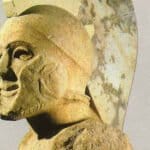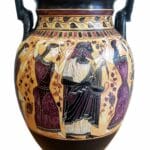Guys, Gods, and Glamour: Decoding Roman Bronze Ephebes
Imagine strolling through a museum, your gaze drawn to a statue of a graceful young man, eternally frozen in bronze. You’ve likely encountered a Roman ephebe, a captivating figure embodying much more than just physical perfection. These sculptures, with their chiseled physiques and serene expressions, held deep cultural significance in ancient Rome.
Roman society, much like our own, was captivated by youth, athleticism, and idealized beauty. The ephebe, often depicted in the prime of youth, symbolized these ideals, representing the very essence of Roman virtue and vitality.
But their meaning goes beyond mere aesthetics. Found in grand villas, public baths, and even sacred temples, ephebes likely played diverse roles in Roman life. Some scholars suggest they represented mythological heroes and gods, bridging the earthly and divine realms. Others theorize they served as good luck charms, offered as gifts to deities or used to adorn homes with an air of sophistication.
Consider the “Ephebe of Sutri,” dating back to approximately 480 BC. His perfectly balanced posture and idealized physique hint at the strong influence of Greek art on Roman aesthetics. This influence is further evident in the “Roman Ephebe from Naples” (circa 1st century BC), though this statue showcases a more lifelike, distinctly Roman style with its incredibly detailed musculature and dynamic drapery.
The “Ephebe of Tiber,” recovered from the Tiber River (2nd century AD), presents a more intriguing narrative. It is believed to depict Emperor Hadrian as a young athlete, strategically linking his image with youthful vigor and divine right – a bold political statement immortalized in bronze.
The discovery of sites like the “House of the Ephebe” in Pompeii, a dwelling frozen in time with an ephebe statue as its centerpiece, provides us with intimate glimpses into how Romans lived with these captivating works of art.
So, the next time you encounter a Roman bronze ephebe, take a moment to appreciate its timeless beauty. Consider the stories it might tell – narratives of Roman aspirations, their beliefs, and their enduring fascination with youth and the human form. These sculptures are not merely silent relics; they are windows into a bygone world, brimming with intrigue and enduring allure.
Unlocking the Mysteries of the Antikythera Youth
The Antikythera Shipwreck is renowned for its treasures, but few are as captivating as the bronze statue known as the “Bronze Youth of Antikythera.” Discovered in 1900 amidst the ancient wreckage, this nearly 2,000-year-old statue offers a breathtaking glimpse into the artistry of the Greeks circa 340-330 BC. Today, it stands as a prized exhibit in the National Archaeological Museum in Athens.
Standing slightly taller than a basketball player at 1.96 meters, the statue’s lifelike quality is striking. However, its true identity remains an enigma. Some experts propose it depicts Paris, the Trojan prince of Greek mythology. Others suggest it portrays the legendary hero Heracles or even Perseus, slayer of Medusa. Each theory presents a compelling piece of the puzzle, yet the statue’s true meaning remains elusive.
Adding to the intrigue is the statue’s pose. Discovered in fragments and meticulously restored in the 1950s, the current arrangement of its limbs, while graceful, has sparked debate. Did the restorers accurately capture the original stance, or did the artist intend a different posture altogether? This question continues to fascinate art historians and archaeologists.
The Bronze Youth of Antikythera is more than just a statue; it is a tangible enigma, a reminder that the ancient world still holds secrets waiting to be unraveled. It beckons us to keep exploring, questioning, and imagining the stories behind these remarkable artifacts. Who knows what other mysteries lie hidden beneath the waves, waiting to be discovered?
Unveiling the Bronze Emperors: Power Cast in Metal
Across Europe’s esteemed museums, bronze statues of Roman emperors stand as silent yet powerful testaments to a glorious past. These sculptures, crafted from an alloy of copper and tin prized for its strength and permanence, offer us a glimpse into the artistry, politics, and beliefs of ancient Rome.
The creation of these statues was a testament to Roman craftsmanship. Skilled artisans would meticulously mold wax into incredibly detailed figures using the lost wax technique. This wax model was then encased in clay and heated, melting the wax and leaving a hollow mold. Molten bronze was poured into this void, and upon cooling, the mold was chipped away to reveal the emperor, immortalized in metal.
But these statues were more than just aesthetically pleasing; they were carefully crafted to project an image of power and authority. Emperors were often depicted as youthful, vigorous, and even god-like – a calculated strategy to reinforce their rule and inspire awe in their subjects, crucial for maintaining control over a sprawling empire.
Some of these bronze masterpieces have endured through the ages. The statue of Augustus, the first Roman emperor, housed in the Vatican Museums, depicts him in all his majestic glory, a symbol of imperial might. The statue of Tiberius, discovered in Herculaneum, portrays him in priestly robes, emphasizing his religious authority.
The bronze head of Claudius, residing in the British Museum, is a rare treasure, as large-scale bronze portraits from his era are uncommon. Equally remarkable is the statue of Trebonianus Gallus, now in the Metropolitan Museum of Art, one of the few surviving bronze statues from the tumultuous 3rd century, offering valuable insights into the art and politics of that era.
These bronze emperors are not merely statues; they are tangible links to a mighty empire that shaped the course of history. They continue to captivate us with their beauty, historical significance, and the silent narratives they convey about the men who ruled one of the world’s most influential civilizations.
What is Roman Bronze Made Of? Decoding the Alloy of Empire
Roman bronze, renowned for its strength and durability, was the material of choice for everything from everyday tools to grand statues. However, its composition was not a fixed formula but rather a carefully crafted blend of metals, with variations depending on the intended purpose and desired properties.
While copper (Cu) and tin (Sn) were the primary components, with copper making up roughly 88% and tin 12%, Roman bronze often incorporated other elements. Lead (Pb), zinc (Zn), silver (Ag), and iron (Fe), either intentionally added or present as impurities in the original ore, played crucial roles in influencing the alloy’s color, fluidity, and durability. For instance, increasing the tin content created a harder, more durable bronze suitable for coins, while different ratios of trace elements produced subtle variations in color.
This adaptability in bronze production highlights the Romans’ sophisticated understanding of metallurgy. They were able to manipulate the alloy’s composition to achieve specific properties for different applications, showcasing their mastery of this versatile material.
The study of Roman bronze composition provides valuable insights into their technological prowess, helps authenticate and date artifacts, and informs conservation efforts. By analyzing the precise ratios of elements present, researchers can glean valuable information about the origins, age, and even the intended use of Roman bronze objects.
Sadly, the vast majority of Roman bronzes were melted down and recycled throughout history, making the surviving pieces even more precious. It is estimated that only 100 to 200 bronze sculptures from the Hellenistic period have survived to this day. This scarcity underscores the importance of thoroughly analyzing and documenting existing Roman bronze artifacts to preserve the knowledge and artistry they embody.
Want to see how Pieter Bruegel depicted a world overtaken by skeletons? Check out Pieter Bruegels ‘Triumph of Death’.
- Unlock Filipino Culture: A Deep Dive into Traditions and Practices - April 23, 2025
- Unlock Spanish Culture: Insights & Opportunities Now - April 23, 2025
- White Spirit Uses & Substitutes: A Deep Dive for Pros & DIYers - April 23, 2025

















1 thought on “Unveiling the Mysteries of the Roman Bronze Ephebe”
Comments are closed.